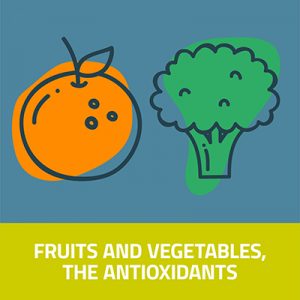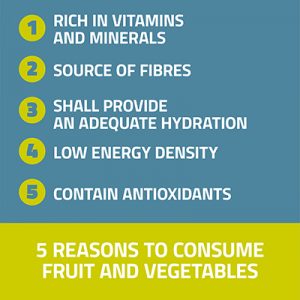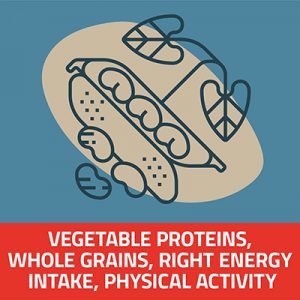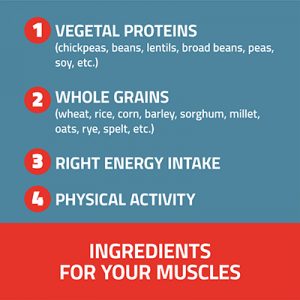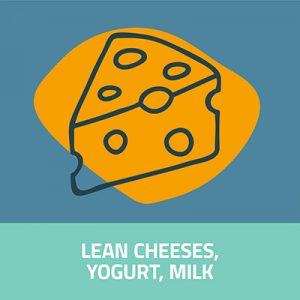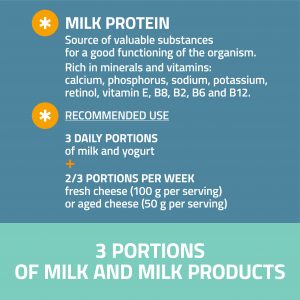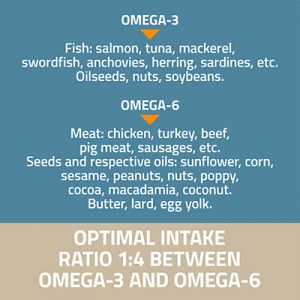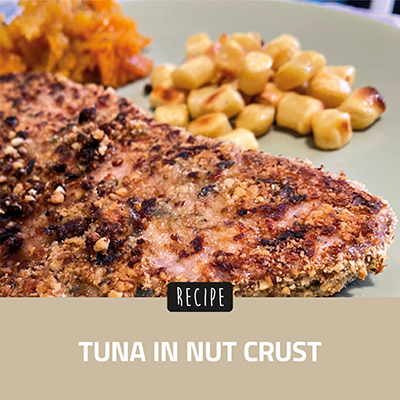6. ARE YOU AWARE
OF THE ADVANTAGES OF A HEALTHY DIET?
OF THE ADVANTAGES OF A HEALTHY DIET?

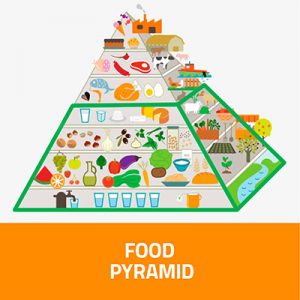
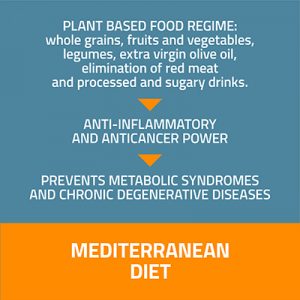
Cardiovascular disease and cancer are the most common causes of death in Europe and the United States. The American Institute for Cancer Research estimated that proper nutrition could prevent these deaths by 30 to 50%.
Because of the close link between nutrition and cancer, an international research group has been set up for years – the World Cancer Research Fund (WCRF) – which, in 2007, drew up ten lifestyle recommendations to prevent certain cancers.
The same recommendations are basically based on maintaining a healthy weight through physical activity, adopting a diet with whole grains, fruits and vegetables, legumes, restriction of red and processed meat and sugary drinks.
In accordance with the rules of the WCRF are the principles of the Mediterranean diet, in particular the “plant-based” one that is based on the consumption of plant fibers and proteins. Studies of nutrigenomics show that the consumption of extra virgin olive oil, cereals, fruits and vegetables, have an important anti-inflammatory and antitumor power.
Data from cohort and case-control studies have shown that a diet based on the Mediterranean diet, in addition to preventing metabolic syndromes such as type 2 diabetes and chronic-diseasedegenerative, is associated with a reduction in the risk of developing certain types of cancer such as those of the gastroenteric tract, stomach, colorectal, pancreas, liver and hormonal-related tumors such as those of the endometrium.
5 REASONS TO CONSUME
FRUIT AND VEGETABLES
FRUIT AND VEGETABLES
- They are rich in vitamins and minerals, especially if they are in season.
- They are excellent sources of fiber.
- They contribute to having adequate daily hydration.
- They help maintain a healthy body weight due to their low energy density.
- They contain bioactive molecules that play a fundamental role in health: antioxidants.
Antioxidants are a group of molecules that can counteract, slow and neutralize the formation of oxygen radicals that are formed as a result of oxidation reactions. Such reactions, if in excess, are the basis of oxidative stress processes and often contribute to the onset of chronic-degenerative diseases, including tumors.
Therefore, we can define them as factors of primary and secondary protection and prevention against overweight, obesity and chronic-degenerative diseases (cardiovascular and oncological).
In addition to having good reasons to regularly consume fruits and vegetables, 5 are the portions of fruits and vegetables to be consumed every day according to WCRF recommendations.
4 INGREDIENTS FOR YOUR MUSCLES
To combat sarcopenia (loss of muscle mass and its function regardless of weight), a very frequent condition in the cancer patient, you need 4 simple ingredients. Let’s start from the basics or proteins that are macronutrients with a plastic role. Proteins are usually linked to foods of animal origin, such as meat and fish. According to the WCRF recommendations it is indicated that a plant-based food lifestyle is more protective for health. In fact, proteins are not only found in products of animal origin, but also in products of plant origin. Among the main sources of vegetable protein we mention legumes that must be combined with cereals (possibly whole) to ensure the adequate intake of 9 essential amino acids, essential to ensure the maintenance of muscle mass.
It is also essential to ensure a proper energy intake that must be adequate for energy expenditure and ensured by a proper intake of energy nutrients (carbohydrates and lipids). If the latter are taken in a lower amount than the need, to cover such energy shortage are used proteins, which as a result, will no longer be available for muscle building and functionality.
Finally, as a last ingredient, there is physical activity that has the role of maintaining muscle activities against a proper intake (intake) energy and protein.
It is highly recommended to remain physically active even during medical-oncological treatments and follow-up successes, since a sedentary lifestyle inevitably leads to loss of muscle mass and strength, as well as a worsening of the pathophysiology of the patient himself.
3 PORTIONS OF MILK AND MILK PRODUCTS
In recent years the consumption of milk and dairy products has often been wrongly demonized, convinced of their correlation with the onset of cancer, thus creating countless doubts and fears in consumers and patients. However, there is scientific evidence of a protective effect of milk and dairy products, in particular for certain types of cancer, such as breast and colon cancer. This effect is dose-dependent and type-dependent, that is, we refer to lean and fermented cheeses. In this regard, the WCRF suggests the assumption of the latter by placing them in a privileged position of the food pyramid.
Milk and dairy products are sources of valuable substances for the good functioning of the body including milk proteins, which are complete from the point of view of the content of amino acids and perform fundamental functions such as the defense against microorganisms and the facilitation of the absorption of nutrients, in particular calcium. They are rich in minerals and vitamins, including calcium, phosphorus, sodium, potassium, retinol, vitamin E, biotin (vitamin B8), riboflavin (vitamin B2) and other B vitamins (B6 and B12).
In this regard, the Italian Society of Human Nutrition (SINU) and the Council for Research in Agriculture and Analysis of Agricultural Economics (CREA) recommend 3 servings daily of milk or yogurt (one serving corresponds to 125 ml of milk or 125 g of yogurt), to which should be added 2 to 3 servings per week of fresh cheese (100 g each) or seasoned (50 g). Among the types of fresh cheeses with lower fat content, you can choose between cottage cheese, light mozzarella, stracchino light, ricotta vaccina, crescenza light and philadelphia light.
2 ESSENTIAL THINGS: OMEGA-3 AND OMEGA-6
Essential fatty acids are defined as a class of lipids that must be taken with food because humans cannot synthesize them. Specifically, these are:
Alpha linolenic acid (ALA):
- Parent of omega 3 fatty acids.
- Promoter of the production of fatty acids called EPA and DHA, works in synergy with molecules called elongases (enzymes that allow the synthesis of the same fatty acids).
Linoleic acid (LA):
- Parent of omega 6 fatty acids.
- Promoter of the production of arachidonic acid with elongases.
Before talking about the effects and functional implications of fatty acids, it is important to know where we can find them and which foods we prefer as main sources.
Omega 3:
- ALA is typical of vegetables and we can find it in the oily seeds, germ or embryo of the other seeds (also the starchy ones). For example: flaxseed, chia seeds, nuts and soybeans.
- EPA and DHA are mainly contained in food of animal origin, in particular in fish (salmon, tuna, mackerel, swordfish, anchovies, herring, sardines etc.).
Omega 6:
- LA is more abundant in plant foods than animal ones, especially we can find it in some seeds and their respective oils such as sunflower, corn, sesame, peanuts, nuts, poppy, cocoa, macadamia, coconut and also in butter, lard, egg yolk.
- Arachidonic acid is mainly contained in food of animal origin and is mainly supplied by meat (chicken, turkey, beef, pork, pig meat, etc.).
Among the countless functions of essential fatty acids, we highlight their contribution in the regulation of inflammation as they produce substances called eicosanoids (prostaglandins and thromboxanes), or lipid mediators with pro-inflammatory and anti-inflammatory action depending on the starting substrate. In particular:
- A diet rich in omega 3 leads to the synthesis of EPA and DHA leading to the formation of anti-inflammatory eicosanoids (prostaglandins and thromboxanes of the 2 series).
- A diet rich in omega 6 leads to the synthesis of arachidonic acid useful for the production of inflammatory eicosanoids (prostaglandins and thromboxanes of series 3).
It is essential to maintain a balance between these substances. In fact, when pro-inflammatory substances prevail, the appearance of chronic pathologies based on degenerative phlogistic, including tumors, is favored. As we have seen, arachidonic acid is mainly contained in meat mainly present in the “Western” (western) diet characterized by a pro-inflammatory profile.
Moreover, prostaglandins, also inflammatory, have been shown to stimulate the mechanisms of angiogenesis that lead to the synthesis of new blood vessels. The creation of a new network of blood vessels is built to provide oxygen and nutrients to cancer cells to ensure their proliferation and survival.
In conclusion, to maintain a good balance between fatty acids in the body, it would be optimal intake of omega 3 and omega 6 respecting the ratio 1:4 (omega 3: omega 6) even if our diet is usually more unbalanced towards omega 6.
If you want a food with an almost perfect ratio between omega 3 and omega 6 we recommend nuts.
1 ONCE IN A WHILE: SWEET TEMPTATIONS
Sugars are common elements of our diets and can be found in foods and beverages, both in natural form and as additives, but also in foods that are not apparently sweet. In recent decades, due to increased sugar consumption and the incidence of obesity and related diseases, the role of sugar has been questioned.
Sugars are the primary energy source for our body, in particular glucose, which can be considered the fuel that feeds our cells and allows them to perform vital functions. Cancer cells are characterized by uncontrolled cell proliferation and it is precisely glucose that sustains them.
To date, there is no scientific evidence of a direct correlation between sugar intake and cancer onset as stated by WCRF. Conversely, there is an indirect correlation due to overweight/obesity that would increase the incidence of oncological pathologies. Ten types of cancer related to overweight/obesity are known.
For this reason, among the 10 WCRF recommendations for cancer prevention, there is also an indication to avoid the consumption of sugary drinks and to follow the recommendations of experts for a more conscious sugar consumption. The World Health Organization (WHO) recommends a consumption of sugar equal to 10% of the Kcal daily, or not to exceed about 50 grams of sugar for women and 70 grams for men, based on physical activity.
In addition, there is no difference between white sugar and cane sugar, with the exception of the processing technique. To conclude, it is essential to limit the consumption of sugar (sweets and sugary drinks) although occasionally enjoying some sweet notes of your favorite dessert following the instructions of experts, does not alter in any way a regular healthy lifestyle.




